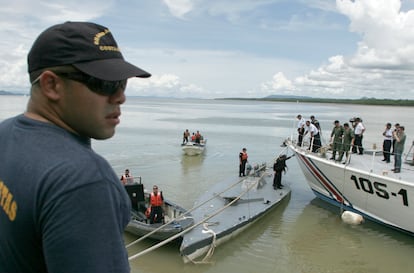La Señora’s submarines: The network that supplied cocaine traffickers on the high seas
The U.S. Department of Justice has built a case against a group of traffickers who transported drugs in small boats along the Pacific, making stops in Mexico and Central America

A small ship navigates the Pacific with apparent normality. And it’s not alone — behind it, there are dozens more. The small ship never docks at any port to reload supplies. It tries to go unnoticed as it makes its way from the coast of Ecuador to some point in Mexico or Central America, where it can dock without attracting attention. To achieve such a trip without making a single stop, an entire network of boats is required. Some are fishing boats and others are semi-submersible; they supply the transport ship with fuel and food on the high seas. The reason the ship seeks to avoid the spotlight is because it’s carrying more than a ton of cocaine.
The sentence handed down by the National Court of Madrid against Carmen Mireya Alarcón — who was, for a time, the most-wanted fugitive on the continent— paints a portrait of how the networks that supply drug traffickers at sea work to evade the authorities. Carmen Mireya Alarcón, a citizen of Ecuador, was arrested in Barcelona in April 2021. “La Señora” — as she was called within her criminal group — assured the arresting police officers that they had made a mistake.
“I don’t even live in Spain; I went to pick up my husband with the lawyer,” Alarcón told them, as this newspaper reported at the time. La Señora had traveled to Barcelona to help her husband, who had been arrested at the El Prat airport a few days before. Both had warrants issued by the Southern District of California. They were wanted for the crime of drug trafficking. Finally, they have been extradited to the United States and are currently facing a criminal case.
Alarcón was allegedly one of the leaders of a criminal network that supplied the offshore fishing boats that sought to evade authorities while moving cocaine from the coast of Ecuador to Mexico and Central America, before smuggling it into the United States.
Born in Manta, the detainee also holds a Spanish nationality, which is why she used Spain as a kind of temporary refuge. In Ecuador — where her business was based — she was linked to a company supposedly dedicated to the wholesale and retail sale of fishery products. The company — based in the coastal province of Manabí — operated for at least a decade.

Suspicious about what was happening on the high seas, U.S. authorities opened an investigation in August 2017, in search of a criminal organization with its headquarters in Mexico and another in Ecuador, which was trafficking drugs into the U.S. The investigation led them to discover several “networks of owners and captains of commercial fishing vessels” from the Ecuadorian city of Manta, who used their boats to “refuel a large number of vessels loaded with drugs.” Among the owners of these ships were Alarcón and her husband, Pedro Cornelio Pilligua Iduarte.
In 2020, the U.S. Department of Homeland Security tapped the phone calls being made by this group of suspected traffickers, who used Iridium satellite phones to avoid being tracked. The formal U.S. indictment against La Señora is for her alleged use of a fishing vessel — registered in her name — to resupply multiple drug-filled ships.
According to the document, she didn’t act alone, but worked alongside other captains to “coordinate the transportation of large quantities of cocaine from Colombia and Ecuador to the coasts of Mexico and other South American countries.”
Included in the evidence are the transcripts of the calls between the alleged traffickers. An example from May 31, 2020, saw the U.S. Coast Guard intercept two vessels about 300 miles off the coast of Guerrero, Mexico. In the two boats — in which there were a total of five people — officers found over 1,500 pounds of cocaine, along with some laminated cards that detailed the location of the points on the high seas where they had to stop to refuel. There were also telephone numbers that were used to communicate with others, in case supplies were needed. One of these numbers was registered to Alarcón.
When reviewing the history of Alarcón’s calls, authorities found that the woman had acted as a “coordinator on the ground” in the days prior to the arrest. Her role was to inform captains of other ships (that were also carrying drugs) of the coordinates needed to find a boat in the middle of the ocean that could supply fuel and food.
Another clue came in August 2020, when the Coast Guard found a ship that had 5,200 pounds of cocaine hidden under a specially-designed cover. They found that the boat had had contact with Alarcón’s phone during its voyage — her network had been supplying the ship with provisions along the way.

The communications also indicate that the woman coordinated the departure of the ship loaded with drugs and the points where it was to be refueled.
“Good morning, has [that ship] passed by your location yet?” Alarcón asks another person via text. “Negative,” reads the reply. “The uncle called last night and said that it would pass near the Maria (the name of the supply ship) in three days. Find out and let me know.”
A few hours later, La Señora initiates another conversation, in which she says that the ship hasn’t arrived yet “because there are strong winds.” Someone tells her that they don’t have “much food or diesel.”
“It should arrive today,” she reassures them. “Delete the messages.”
Once in the crosshairs of the authorities, Ecuadorian police followed Alarcón to a meeting at a restaurant in Manta with her associates from the boats. There, they were photographed by the security forces. Fishing businessmen from Ecuador, sailors and a group of Colombians were involved in the network, which carried the drug from laboratories in the rural areas of Cauca and Nariño, in Colombia, to the Pacific coast in that country and in Ecuador.
In June 2022, Colombia authorized Alejandro Estupiñán Alzate’s extradition to the United States, to stand trial for 10 drug trafficking charges for allegedly having moved cocaine from those laboratories in the Colombian southwest to the starting points of the routes in the Pacific.
The arrests, however, didn’t stop the flow of cocaine. Authorities have continued to stop or find boats moving drugs from South America to Mexico or Central America. So far this year, the Attorney General’s Office in Mexico has reported three operations linked to ships that transported cocaine along the Mexican coast: two of them in Michoacán and one in Chiapas. Of the 13 detainees, eight are citizens of Ecuador.
At the end of last year, Ecuador experienced a few days of violence carried out by criminal organizations that operated in alliance with the Mexican cartels, mainly the Jalisco Nueva Generación cartel (CJNG) and the Sinaloa Cartel. These two gangs – which have been fighting for years over the drug trade in Mexico – have long since ceased to be solely national organizations. Now, they have a significant part of their operations in South America. Ecuador has become one of the main drug corridors from Colombia to Europe, the United States and Central America.
Sign up for our weekly newsletter to get more English-language news coverage from EL PAÍS USA Edition
Tu suscripción se está usando en otro dispositivo
¿Quieres añadir otro usuario a tu suscripción?
Si continúas leyendo en este dispositivo, no se podrá leer en el otro.
FlechaTu suscripción se está usando en otro dispositivo y solo puedes acceder a EL PAÍS desde un dispositivo a la vez.
Si quieres compartir tu cuenta, cambia tu suscripción a la modalidad Premium, así podrás añadir otro usuario. Cada uno accederá con su propia cuenta de email, lo que os permitirá personalizar vuestra experiencia en EL PAÍS.
¿Tienes una suscripción de empresa? Accede aquí para contratar más cuentas.
En el caso de no saber quién está usando tu cuenta, te recomendamos cambiar tu contraseña aquí.
Si decides continuar compartiendo tu cuenta, este mensaje se mostrará en tu dispositivo y en el de la otra persona que está usando tu cuenta de forma indefinida, afectando a tu experiencia de lectura. Puedes consultar aquí los términos y condiciones de la suscripción digital.
More information
Archived In
Últimas noticias
Most viewed
- Oona Chaplin: ‘I told James Cameron that I was living in a treehouse and starting a permaculture project with a friend’
- Reinhard Genzel, Nobel laureate in physics: ‘One-minute videos will never give you the truth’
- Sinaloa Cartel war is taking its toll on Los Chapitos
- Why the price of coffee has skyrocketed: from Brazilian plantations to specialty coffee houses
- Silver prices are going crazy: This is what’s fueling the rally










































